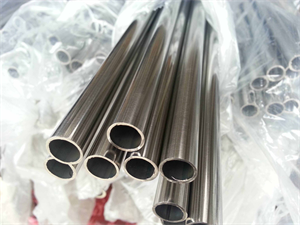Is there a way to identify 316 stainless steel?
Steel material 304 and 316 identification methods are as follows:
Identification of color and luster
After pickling of stainless steel, the surface color and lustre silver white and clean: chromium-nickel stainless steel color silver white jade; chromium stainless steel color white slightly gray luster is weak; chromium-manganese-nitrogen stainless steel color and chromium-nickel stainless steel is similar to the color and lustre is slightly lighter. The surface color of the stainless steel without pickling: chromium-nickel steel is brownish white, chromium steel is brownish black, and chromium manganese nitrogen is black (these three colors refer to the oxidation of the heavier color). Cold rolled unannealed chromium-nickel stainless steel, the surface of silver-white reflective.
Identification with a magnet
Magnets can basically distinguish between the two types of stainless steel. Because chromium stainless steel in any state can be attracted by magnets; chromium-nickel stainless steel in the annealed state is generally non-magnetic, in the cold-worked, some will be magnetic. However, high manganese steel containing high manganese is non-magnetic; the chromium-nickel-nitrogen stainless steel magnetic situation is more complex: some are non-magnetic, some magnetic, and some longitudinal surface is a non-magnetic and magnetic cross-section. Therefore, although the magnet can basically distinguish chromium stainless steel and chromium-nickel stainless steel, but can not correctly distinguish some of the special properties of the steel, and also can not distinguish the specific steel number.

Identification with copper sulfate
Will remove the oxide layer on the steel, put a drop of water, with copper sulfate rub, rub, such as no color change, generally for stainless steel; such as purple red, non-magnetic for high manganese steel, magnetic generally for ordinary steel or low alloy steel.
For special properties of steel, we also need to take the following three ways to identify.
Abrasive identification
Grinding flower identification is the stainless steel in the grinder, view its sparks. If the spark is streamlined, and there are more dense knots, that is, high manganese-containing high manganese steel or manganese-nitrogen steel; such as no knots that is chromium steel or chromium-nickel stainless steel.
Annealing method of identification
Cold working chromium-nickel stainless steel, such as magnetic, can take a small piece of red in the fire to let it cool naturally or into the water (annealing), generally speaking, after annealing the magnetic properties will be significantly weakened or completely disappeared. But some chromium-nickel stainless steel, such as Cr18Ni11Si4AlTi steel and Cr21Ni5Ti steel, because the steel contains more ferrite elements, and its internal organization has a considerable part of ferrite. Therefore, even in the state of hot working, there are magnetic.
Chemical characterization method
The chemical characterization method is to identify the magnetic stainless steel containing nickel is an identification method. The method is to dissolve a small piece of stainless steel in aqua regia, use clean water to dilute the acid, add ammonia neutralization, and then gently injected it into the nickel reagent. If there is a red fluffy material floating on the liquid surface, that is, indicating that the stainless steel contains nickel; if there is no red fluffy material, that is, to prove that the stainless steel is without nickel.


